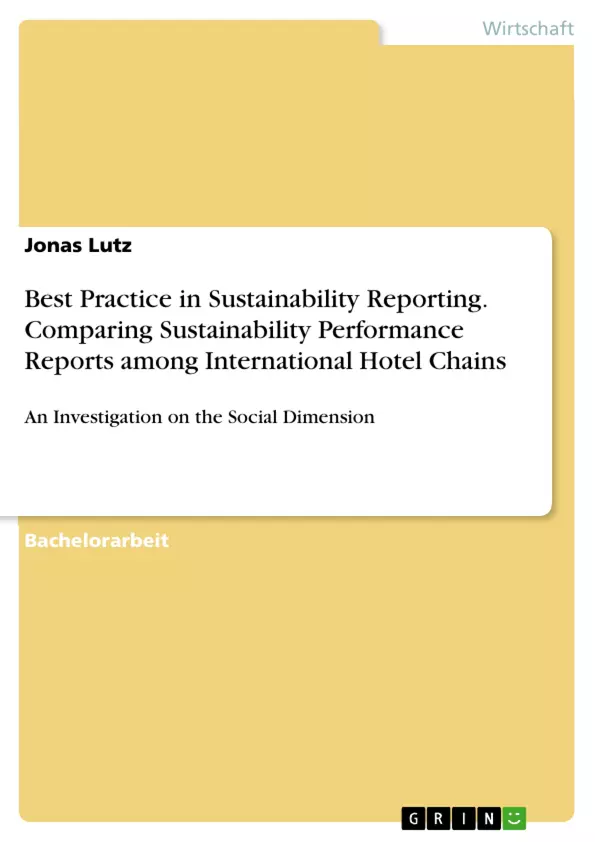This thesis investigates the reasons of sustainability reporting on the social dimension of the biggest hotel companies worldwide and examines their utility from a marketing perspective. The usefulness and comparability of sustainability reports published by these companies is assessed using a content analysis of seven reports. The findings of the research, together with a review of existing reporting frameworks, lead to the conclusion that reporting on the social dimension lies behind the other dimensions. As there is still room for improvement, the communication of the sustainability efforts taken works very well. To reach the full potential of sustainability reporting on the social dimension sector-specific guidance for the hospitality industry and commonly social indicators are suggested.
Inhaltsverzeichnis
- ABSTRACT
- LIST OF TABLES
- LIST OF FIGURES
- LIST OF APPENDICES
- LIST OF ABBREVIATIONS
- 1 INTRODUCTION
- 1.1 JUSTIFICATION AND CURRENCY OF THE TOPIC
- 1.2 AIM OF THE THESIS AND RESEARCH OBJECTIVES
- 1.3 TARGET AUDIENCE
- 2 LITERATURE REVIEW
- 2.1 SUSTAINABLE DEVELOPMENT
- 2.1.1 SUSTAINABILITY AWARENESS
- 2.1.2 DEFInition of SusTAINABILITY
- 2.1.3 TBL- TRIPLE BOTTOM LINE
- 2.1.4 NINE PRINCIPLES OF SUSTAINABILITY PERFORMANCE
- 2.1.5 CORPORATE SOCIAL RESPONSIBILITY
- 2.1.6 BENEFITS and VALUES
- 2.2 STAKEHOLDERS OF A BUSINESS
- 2.2.1 INTERNAL STAKEHOLDERS
- 2.2.2 EXTERNAL STAKEHOLDERS
- 2.2.3 CORE & FRINGE STAKEHOLDERS
- 2.3 MARKETING TOOLS OF BUSINESS
- 2.3.1 MARKETING & SUSTAINABILITY
- 2.3.2 INTEGRATED MARKETING COMMUNICATION
- 2.4 SUSTAINABILITY REPORTING
- 2.4.1 PURPOSE OF REPORTING
- 2.4.2 HISTORY OF SUSTAINABILITY REPORTING WITHIN THE HOSPITALITY INDUSTRY
- 2.4.3 ELEMENTS OF SUSTAINABILITY REPORTS
- 2.4.4 REACTIONS AND CRITICISM TOWARDS SUSTAINABILITY REPORTING
- 2.5 STANDARDIZATION OF SUSTAINABILITY REPORTS
- 2.5.1 GLOBAL REPORTING INITIATIVE
- 2.5.2 INTERNATIONAL ORGANIZATION FOR STANDARDISATION
- 2.6 CHAPTER SUMMARY
- 2.1 SUSTAINABLE DEVELOPMENT
- 3 RESEARCH METHODOLOGY
- 3.1 RESEARCH PHILOSOPHY
- 3.2 RESEARCH PROCESS
- 3.2.1 RESEARCH DESIGN
- 3.2.2 DATA COLLECTION METHOD
- 3.2.3 COMPARATIVE FRAMEWORK
- 3.2.4 QUALIFYING SAMPLE
- 3.2.5 LIMITATIONS AND BIAS
- 3.2.6 EVALUATION OF CHOSEN METHODOLOGY
- 4 CONTENT ANALYSIS OF THE SOCIAL DIMENSION
- 4.1 INTRODUCTION TO THE HOTEL COMPANIES
- 4.1.1 INTERCONTINENTAL HOTELS GROUP PLC
- 4.1.2 HILTON WORLDWIDE HOLDINGS INC.
- 4.1.3 MARRIOTT INTERNATIONAL, INC.
- 4.1.4 WYNDHAM WORLDWIDE CORPORATION
- 4.1.5 ACCOR S.A.
- 4.1.6 CHOICE HOTELS INTERNATIONAL, INC.
- 4.1.7 STARWOOD HOTELS & RESORTS, INC.
- 4.1.8 BEST WESTERN INTERNATIONAL, INC.
- 4.1.9 HOME INNS & HOTELS MANAGEMENT INC.
- 4.1.10 THE REZIDOR HOTEL GROUP, AB
- 4.2 COMPARISON OF SOCIAL INDICATORS
- 4.1 INTRODUCTION TO THE HOTEL COMPANIES
- 5 RESEARCH FINDINGS
- 5.1.1 LABOR PRACTICES
- 5.1.2 HUMAN RIGHTS DISCLOSURES COMPARISON
- 5.1.3 SOCIETY DISCLOSURE COMPARISON
- 5.1.4 PRODUCT RESPONSIBILITY DISCLOSURE COMPARISON
- 6 DISCUSSION
Zielsetzung und Themenschwerpunkte
Diese Bachelorarbeit untersucht die Gründe für die Berichterstattung über die soziale Dimension der Nachhaltigkeit bei den größten Hotelgesellschaften weltweit und analysiert deren Nützlichkeit aus Marketingperspektive. Die Arbeit bewertet die Nützlichkeit und Vergleichbarkeit von Nachhaltigkeitsberichten, die von diesen Unternehmen veröffentlicht werden, mithilfe einer Inhaltsanalyse von sieben Berichten. Die Ergebnisse der Forschung, zusammen mit einer Überprüfung bestehender Berichtsrahmen, führen zu dem Schluss, dass die Berichterstattung über die soziale Dimension hinter den anderen Dimensionen zurückliegt. Da es noch Verbesserungspotenzial gibt, funktioniert die Kommunikation der unternommenen Nachhaltigkeitsbemühungen sehr gut. Um das volle Potenzial der Nachhaltigkeitsberichterstattung im sozialen Bereich auszuschöpfen, werden branchenspezifische Leitlinien für die Hotellerie und allgemein gültige soziale Indikatoren vorgeschlagen.
- Analyse der Gründe für die Berichterstattung über die soziale Dimension der Nachhaltigkeit in der Hotellerie
- Bewertung der Nützlichkeit von Nachhaltigkeitsberichten aus Marketingperspektive
- Untersuchung der Vergleichbarkeit von Nachhaltigkeitsberichten verschiedener Hotelketten
- Identifizierung von Stärken und Schwächen der Berichterstattung über die soziale Dimension
- Entwicklung von Handlungsempfehlungen für die Verbesserung der Nachhaltigkeitsberichterstattung in der Hotellerie
Zusammenfassung der Kapitel
Kapitel 1 führt in die Thematik der Nachhaltigkeitsberichterstattung in der Hotellerie ein. Es wird die Relevanz und Aktualität des Themas beleuchtet sowie die Zielsetzung und die Forschungsfragen der Arbeit dargelegt. Kapitel 2 bietet einen umfassenden Literaturüberblick zu den Themen nachhaltige Entwicklung, Stakeholder, Marketing und Nachhaltigkeitsberichterstattung. Es werden verschiedene Definitionen, Konzepte und Standards im Detail vorgestellt.
Kapitel 3 beschreibt die Forschungsmethodik der Arbeit, die auf einer qualitativen Inhaltsanalyse von Nachhaltigkeitsberichten basiert. Es werden die Forschungsdesign, die Datenerhebungsmethode und die Auswahl der Stichprobe erläutert. Kapitel 4 präsentiert die Ergebnisse der Inhaltsanalyse. Es werden die wichtigsten sozialen Indikatoren, die in den untersuchten Berichten aufgezeigt werden, verglichen und analysiert.
Schlüsselwörter
Die wichtigsten Schlüsselwörter dieser Arbeit sind Nachhaltigkeitsberichterstattung, Hotellerie, Global Reporting Initiative, soziale Dimension.
- Citar trabajo
- Jonas Lutz (Autor), 2014, Best Practice in Sustainability Reporting. Comparing Sustainability Performance Reports among International Hotel Chains, Múnich, GRIN Verlag, https://www.grin.com/document/441249



